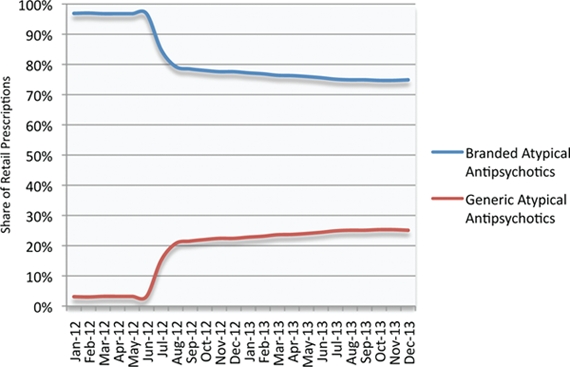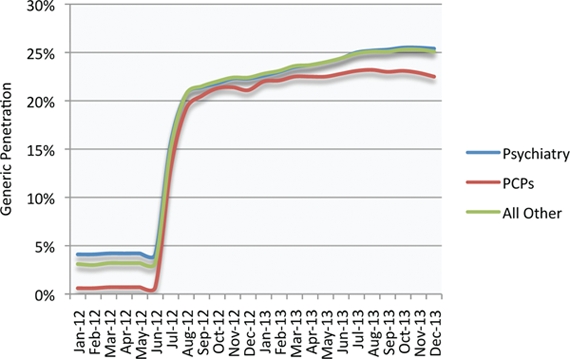Abstract
In this article, we explore the penetration of generic atypical antipsychotics in the United States market before and after the availability of generic risperidone in July 2008. Analysis suggests that, overall, generic penetration into the atypical antipsychotic market has grown from approximately three percent in January 2008 to more than 25 percent in December 2009. Similar trends are uncovered when branded and generic prescriptions are analyzed by specialty.
Keywords: atypical antipsychotic, generic, trade, brand, generic penetration, risperidone, prescription, psychiatrists
Introduction
It has been 18 months since generic risperidone entered the atypical antipsychotic market. We investigated the use of branded versus generic agents in the retail atypical antipsychotic market to understand generic penetration in the atypical antipsychotics overall and by physician specialty.
Methods
We analyzed monthly retail pharmacy prescription data from SDI Health, which captures more than two billion prescriptions per year. This data set includes prescriptions from a variety of retail sources (e.g., national retail chains, mass merchandisers) from a near-census of pharmacies in the United States. The database captures information from all payer types, including cash.
Results
Prescription data suggests that between 2008 and 2009, retail atypical antipsychotic prescriptions grew by 4.3 percent year-on-year. Figure 1 shows that at the beginning of this timeframe, only 3.1 percent of prescriptions in the retail atypical antipsychotic market were for generic products. Between June 2008 and July 2008, generic penetration grew from 3.2 percent to 15.1 percent; a direct result of the availability of generic risperidone beginning in July 2008. Generic penetration, driven mostly by risperidone, reached 25.1 percent of retail atypical antipsychotic prescriptions in July 2009, and held steady around 25 percent through December 2009.
Figure 1.

Share of retail atypical antipsychotic prescriptions: branded products vs. generic products
Source: SDI Health VONA, January 2008–December 2009.
We compared prescriptions for branded versus generic atypical antipsychotics by specialty and found that, like the overall market, there was a jump in generic penetration between June 2008 and July 2008 within psychiatrists, primary care physicians (PCPs), and a grouping of all other specialties writing atypical antipsychotics (Figure 2). Generic penetration trends are similar within the major specialties. Within psychiatry, generics represented 4.1 percent of retail atypical antipsychotic prescriptions in January 2008 and 25.4 percent of prescriptions in December 2009. Analysis of PCP prescribing reveals that generic products represented just 0.6 percent of atypical antipsychotic prescriptions in January 2008 and 22.5 percent of prescriptions in December 2009. Generic penetration has remained slightly lower in PCPs than pyschiatrists over this analysis timeframe.
Figure 2.

Penetration of generic atypical antipsychotic products by specialty
Source: SDI Health VONA, January 2008–December 2009.
Expert Commentary
These provocative data illustrate how generic risperidone, which became available in July 2008, has been used in relation to other second-generation antipsychotics (SGAs). The data are drawn from multiple pharmacy sources and so represent a broad pharmacoeconomic trend analysis. The generic penetration reached 25 percent of prescriptions by July 2009 and retained that rate for the remaining six-month period of observation. The effect is seen among both psychiatrists and primary care physician (PCP) prescribers.
This “uptake” of generic risperidone is not surprising, especially given the extent of clinical experience and robust research data concerning “branded” risperidone. Risperidone was one of the first SGAs to become available and it has been widely used. Its use at that early stage in 1993 and onwards displaced first-generation antipsychotics (FGAs) as drugs of choice. When this trend is considered in the context now of a reformulation of the relative merits of FGAs versus SGAs, the advent of a generic alternative of a SGA represents a key event; especially since cost has weighted heavily in FGA versus SGA comparisons.
Generic alternative to SGAs represent real opportunities for systems of care to save dollars while maintaining a commitment to “modern-day” pharmacotherapy for schizophrenia. It is presently unclear if/when generic substitutes of other current SGAs might become available. This will substantially alter the range of choices for clinicians prescribing SGAs. However, the patents for several SGAs have many years left.
It is also of interest that the availability and increasing use of generic risperidone has not been associated with the same concerns about deterioration with switching drugs. This was a concern when generic forms of clozapine became available, and there were inconsistent reports in the literature. Overall, however, it appears that generic and branded clozapine are therapeutically similar. The same is likely, in my opinion, for generic and branded risperidone.
Contributor Information
Susan Lenderts, Ms. Lenderts is Manager, Strategic Analytics, Quintiles Commercial, Falls Church, Virginia.
Amir H Kalali, Dr. Kalali is Vice President, Global Therapeutic Group Leader CNS, Quintiles, Inc., and Professor of Psychiatry, University of California, San Diego, California.
Peter Buckley, Dr. Buckley is Professor and Chairman, Department of Psychiatry, Medical College of Georgia, Augusta, Georgia.


